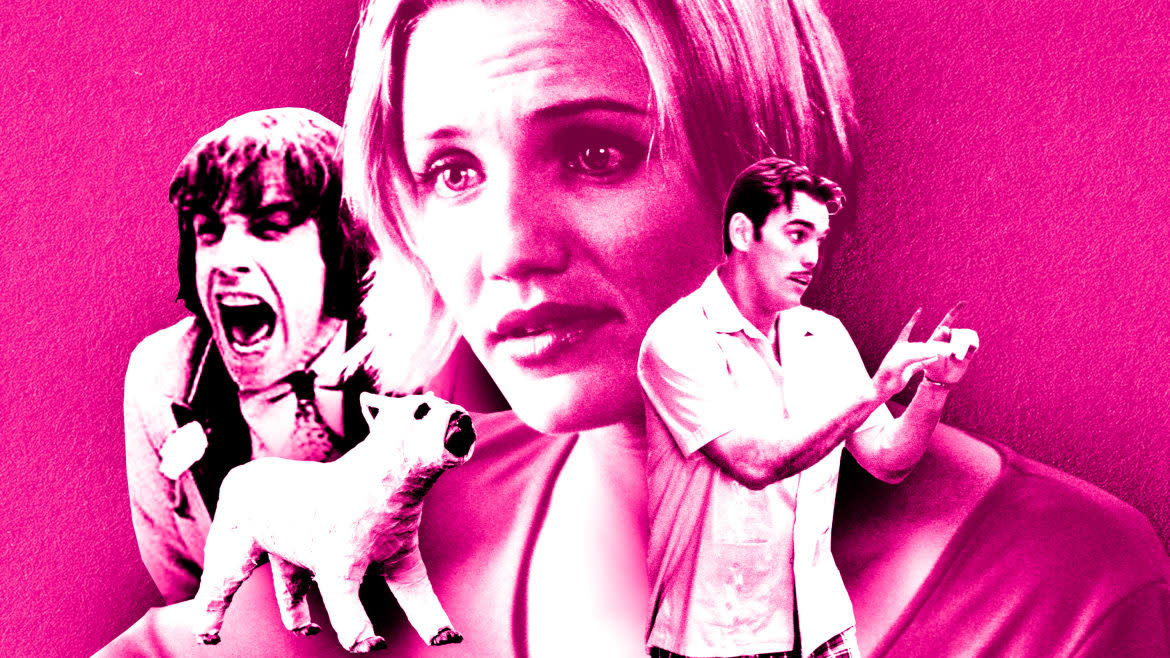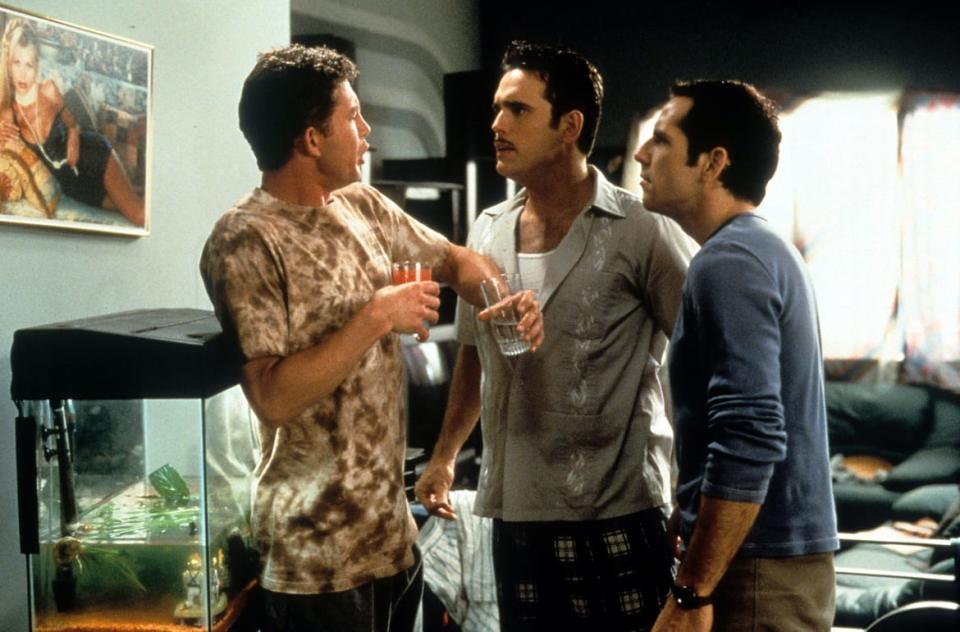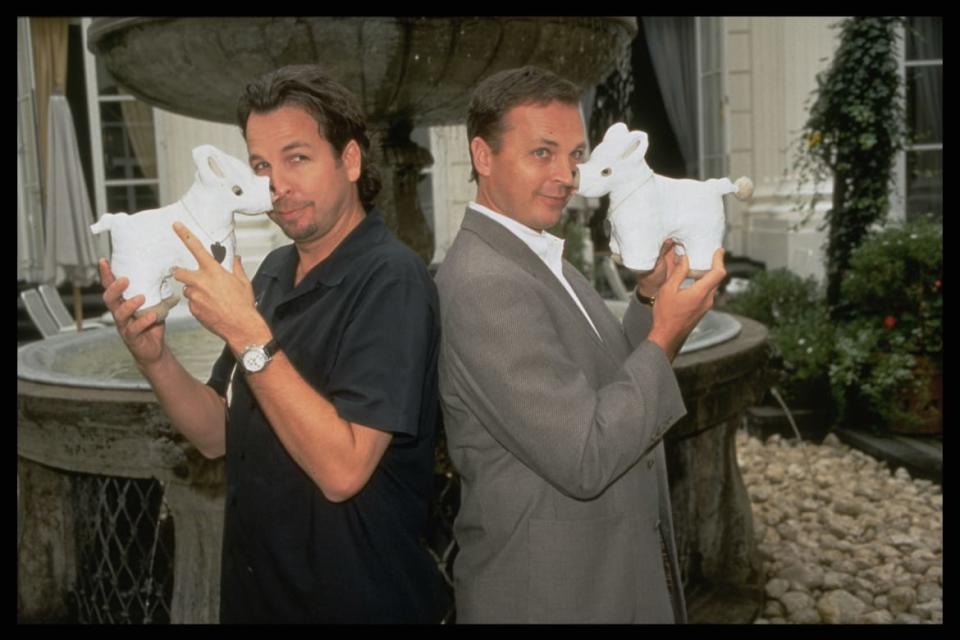The Problematic, Jizz-Soaked Legacy of ‘There’s Something About Mary’

- Oops!Something went wrong.Please try again later.
- Oops!Something went wrong.Please try again later.
- Oops!Something went wrong.Please try again later.
- Oops!Something went wrong.Please try again later.
These days, a bunch of guys lying to get the attention of a beautiful woman would be quickly condemned as catfishing, but in 1998, it was a recipe for box office gold.
Back then, comedy was on the cusp of a “gross-out” craze that was kickstarted, in part, by the success of There’s Something About Mary. The third film from Dumb and Dumber directors Peter and Bobby Farrelly followed Ted (Ben Stiller), an unlucky-in-love loser who hires sleazy private detective Pat (Matt Dillon) to find his long-lost high school crush Mary (Cameron Diaz).
It doesn’t take long for Pat to track her down, but things get weird when he falls for Ted’s all-grown-up prom date and decides to woo her for himself. He’s far from the only person to fall head over heels for Mary, either. Soon, this seemingly perfect woman is stealing hearts left, right, and center—all to the dismay of Ted, who falls behind in the romance race.

Lee Evans, Matt Dillon and Ben Stiller in There’s Something About Mary.
There’s Something About Mary became the fourth-highest-grossing movie of 1998, but like many comedies of times gone by, it hasn’t aged all that well. Packed with gags about bodily fluids, intellectual disabilities, and balls-violently-trapped-in-zippers, it has enough eyebrow-raising bits to make modern viewers squirm in their socially conscious seats. Looking back, its mixture of outrageous shocks and genuine heart has given the film a complicated legacy—but one that its creators own proudly.
“It was a special time because we didn’t know what we were doing,” admits Bobby, taking us back to the mid-’90s. “We didn’t go to film school and we weren’t making a movie where studio execs would say, ‘Yeah, that’s what you do.’ They were thinking, ‘What are you doing? Why would you do that?’ And we were like, ‘Because it makes us laugh and when we showed it to people, it made them laugh too.’ We were making it for audiences and not studio executives.”
Landing on the scene in 1994, the Farrellys found fast fame with their first film, Dumb and Dumber, and followed it up with the bowling comedy Kingpin two years later. Despite eventually becoming a much-loved cult classic, their second movie failed to connect on its theatrical release, which meant their third film suddenly became a make-or-break task if they wanted to keep their careers in Hollywood.
“On every movie, I’m constantly aware that if this isn’t good, you could never work again,” says Peter, reflecting on the fickle nature of the business. “Dumb and Dumber did great, but people just saw it as a Jim Carrey movie and thought we were lucky to be along for the ride, even though we wrote it. I’m not diminishing what Jim did. That movie doesn’t happen without Jim—but we didn’t get much credit.” And with Kingpin becoming a box-office gutterball, “The phone stopped ringing,” Peter recalls. “It was like, ‘Shit. What are we going to do here?’”

Peter and Bobby Farrelly stand back to back holding prop dogs in full body casts in their hands.
Eventually, the duo landed on a script written by their pals Ed Decter and John J. Strauss. Story-wise, it was similar to what There’s Something About Mary ultimately became, though the Farrellys finessed certain things with real-life inspiration.
“We’d always think, ‘What funny things have happened to us and how can we work them into a story?’ and there was a lot of that in There’s Something About Mary,” says Bobby. “A lot of things we drew from our childhood, like when Ben’s character zips himself up in his pants zipper—that happened back home when we were kids.”
It’s true: During a party for their sister, a boy accidentally got into trouble in the bathroom. “The poor kid was in there for a long time trying to figure out how to untangle himself,” Bobby chuckles. Eventually, their father, a doctor, was called in to help. “My dad told us the story years later and we burst out laughing. You draw on your own life experiences and there’s a truth to it because it did happen.”
While the Farrellys were keen to keep the kid behind that tragic moment anonymous, it was Stiller who owned the moment on screen in all its painfully awkward glory. Beating Owen Wilson and Jon Stewart to the role of Ted, Stiller was propelled by There’s Something About Mary into the big time, setting him on a successful career path that he still walks today.
It also sparked a relationship between Stiller and the Farrellys that has spanned 25 years, with the trio reuniting for 2007’s The Heartbreak Kid, as well as the upcoming Christmas comedy Dear Santa, which was written by the brothers, directed by Bobby, and due for release next year.
When it came to casting, Peter and Bobby took advice from their comedy heroes, Airplane! directors Jerry and David Zucker and Jim Abrahams. “One of the most important things they told us is that it’s not so much what happens in the movie, it’s how someone reacts,” Bobby recalls. “Ben is maybe the best reactor we’ve ever dealt with. When something happens around him, the way he looks always pays off the laugh huge.”
Speaking of reaction shots, perhaps the most infamous combination of the duo’s gross-out humor, Stiller’s reactionary chops, and Diaz’s effortless confidence in selling risqué jokes is the scene where Mary mistakes Ted’s jizz for hair gel before a date.
“When the day came to shoot that scene, [Cameron] had a ‘look.’ It might have been her managers talking to her, like, ‘What are you doing? This could ruin your career,’” suggests Bobby. “She thought the hair gel thing was hysterical… if it works,” echoes Peter, “and we understood because we didn’t know either. We were pushing hard with that one, and the studio didn’t even want to shoot it.”
Eventually, the Farrellys agreed to film the scene a few different ways (“We shot it with the hair up, hair down and shiny, and just normal,” recalls Peter) and if it didn’t work, they’d simply cut it. However, to ensure it was as funny as possible, they relied on a props expert to find the right consistency of, erm, residue.
“Somebody hired a guy to make different loads,” Peter laughs. “He showed up with a leather briefcase like a businessman that had 30 or 40 loads in it. We called Ben over and would hold one up at a time, like an earring. People would be like, ‘No, too small.’ ‘Hmm. Kind of lumpy…’ That’s how we decided.” Afterwards, this unusual crew member wasn’t seen again: “The guy shut the briefcase and left,” Peter remembers. “We were laughing, like, ‘Who is that guy and how does he have that job?’”
Thankfully, the trio’s meticulous jizz selection process was worth it. “We got the exact reaction we wanted—people were howling. It was a huge gamble and it paid off. It really defined comedy at the time because it pushed the envelope quite considerably,” says Bobby. “Nobody saw it coming,” adds Peter. “I remember people laughed so hard, they literally fell from their seats into the aisle.”

Ben Stiller with a fish hook pulling his head back while Cameron Diaz looks on in There’s Something About Mary.
Twenty-five years on, the “hair gel scene” has lost none of its hilarious shock value. What hasn’t aged as well, however, is the movie’s depiction of characters with intellectual disabilities. Despite featuring disabled actors in many of their movies—from Kingpin to Bobby’s 2023 comedy Champions—the pair are quick to admit they fell short on this occasion by casting non-intellectually disabled actor W. Earl Brown as Mary’s intellectually disabled brother Warren.
“Warren was based on a guy we grew up with. He was a friend of ours. We laughed with him, he laughed at us—he was just one of the guys, but he had intellectual disabilities,” says Bobby. “We had to fight for that a little bit because we were getting studio notes saying everybody’s going to think you’re picking on people [with intellectual disabilities]. We weren’t—and what’s worse, to pretend they’re not here? It was a big raucous comedy. How come he can’t be part of it? We fought for it and he ended up staying in.
“We’ve grown but Hollywood definitely has too,” he continues. “You wouldn’t put someone in there who didn’t have an intellectual disability, and that’s good because there’s a world of actors with one disability or another and they should be getting parts too because they earn them.”
“I wouldn’t do that today,” Peter agrees. “I would hire an actor with intellectual disabilities—and they’re all over the place—but at that time, they weren’t, and didn’t get the opportunities they’re getting today.”
It’s something that’ll be addressed head-on in a new stage adaptation of the movie that the Farrellys are currently working on. “We’re doing a musical version of There’s Something About Mary. We’ve been developing it for a couple of years and the producers of The Lehman Trilogy are producing it,” Peter reveals. “In it, that role will be played by a person with an intellectual disability.”
Aging issues aside, There’s Something About Mary’s legacy remains a point of pride for its creators and marks a key moment in their filmography. “I think it’s the funniest movie we’ve ever done,” says Peter. “Every day was joyful, and at night we were all just hanging out. It was the most fun I think I’ve ever had on a set.”
Bobby adds: “When it came out, some guy from a hospital called us and said, ‘I hope you don’t mind, but I’ve been showing the movie to people who are dying and they’re laughing so hard, it energizes them.’ Laughter is medicine,” he reasons. “It’s a therapeutic, wonderful thing. We should always laugh and always have comedies—even if sometimes somebody gets offended by them.”
Get the Daily Beast's biggest scoops and scandals delivered right to your inbox. Sign up now.
Stay informed and gain unlimited access to the Daily Beast's unmatched reporting. Subscribe now.

